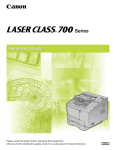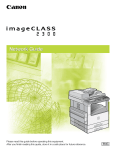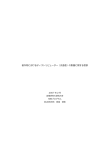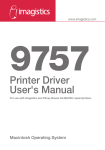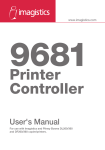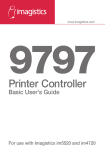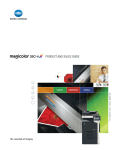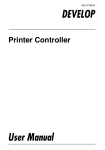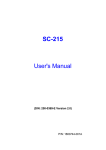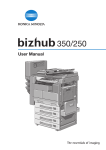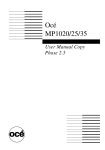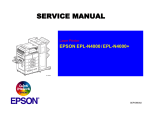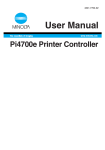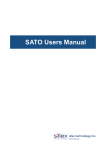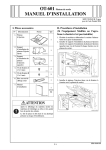Download Printer Driver User`s Manual
Transcript
www.imagistics.com 9757 Printer Driver User's Manual For use with Imagistics and Pitney Bowes DL460/550 copier/printers. Linux Operating System i Welcome Thank you for purchasing the controller. This Operator’s Manual explains how to run print cycles on the machine, to which the controller is connected. It also gives precautions that you should review before attempting to actually use the controller. So, first read this manual carefully and thoroughly; then, keep it close at hand so you can refer to it whenever it becomes necessary. When operating the controller and machine, follow the instructions given in this manual and in the one for the machine. Do not attempt to touch any part that is not covered in these manuals. Never attempt to disassemble or remodel any pieces of equipment, either, to prevent possible hazardous conditions. Some of the screens shown in this manual may look different from what you will view in actual applications. Trademark Acknowledgments Microsoft, Windows 95, Windows 98, Windows 2000 and Windows NT 4.0 are registered trademarks of Microsoft Corporation. Apple, Macintosh and TrueType are registered trademarks of Apple Computer, Inc. IBM and PC/AT are registered trademarks of International Business Machines Corporation. Turbo Linux is registered trademarks of TurboLinux, Inc. SuSE Linux is registered trademarks of SuSE, Inc. Open Linux is registered trademarks of Caldera Systems, Inc. RPM and Redhat Linux are registered trademarks of Red Hat, Inc. Linux is registered trademarks of Linus Torvalds. All other products or brand names are trademarks or registered trademarks of their respective companies or organizations. Adobe, Post Script and the Post Script logo are trademarks of Adobe Systems Incorporated. ii For the U.S.A. Users FCC Part 15-Radio Frequency Devices WARNING This equipment has been tested and found to comply with the limits for a Class A digital device, pursuant to Part 15 of the FCC Rules. These limits are designed to provide reasonable protection against harmful interference when the equipment is operated in a commercial environment. This equipment generates, uses, and radiate radio frequency energy and if not installed and used in accordance with the instruction manual, may cause harmful interference to radio communications. Operation of this equipment in a residential area is likely to cause harmful interference in which case the user will be required to correct the interference at his own expense. The design and production of this unit conform to FCC regulations, and any changes or modifications must be registered with the FCC and are subject to FCC control. Any changes made by purchaser or user without first contacting the manufacturer will be subject to penalty under FCC regulations. FCC-F02 This device must be used with shielded interface cables. The use of nonshielded cables is likely to result in interference with radio communications and is prohibited under FCC rules. For Canada Users Interference-Causing Equipment Standard (ICES-003 Issue 3) This Class A digital apparatus complies with Canadian ICES-003. Cet appareil numérique de la classe A est conforme à la norme NMB-003 du Canada. IC-F03 iii Only for the area of the European Union CE Marking (Declaration of Conformity) This product complies with the following EU directives: 89/336/EEC, 73/23/EEC and 93/68/EEC directives. This declaration is valid for the area of the European Union. This device must be used with shielded interface cables. The use of non-shielded cables is likely to result in interference with radio communications and is prohibited under EU directives. Other countries WARNING This is a Class A product. In a domestic environment this product may cause radio interference in which case the user may be required to take adequate measures. This device must be used with shielded interface cables. The use of nonshielded cables is likely to result in interference with radio communications and is prohibited under CISPR 22 rules and local rules. iv Contents Chapter1 Before Using the Controller 1. Features of the Controller Features of the Controller ................................................ p.1-2 Administrative Functions ................................................. p.1-5 2. Configuration Configuration ................................................................... p.1-6 3. Connecting the Controller Connecting the Controller ................................................ p.1-7 4. Settings Made on the Machine Priority Device ................................................................. p.1-8 On Line/Ready ................................................................. p.1-8 5. Installing the Printer Drivers Installing Various Printer Drivers .................................... p.1-9 Chapter2 Installing the Printer Driver 1. Installation Operating Environment .................................................... p.2-2 Installation ........................................................................ p.2-3 2. Printer setting with Xwindow System Making General Settings Before Using the Printer ......... p.2-5 Redhat Linux .................................................................... p.2-6 Turbo Linux ..................................................................... p.2-9 Open Linux ...................................................................... p.2-12 SuSE Linux ...................................................................... p.2-15 How to display Printer Utility dialog box ........................ p.2-19 3. Use of commands dipjl command .................................................................. p.2-20 Printing method (dilpr command) .................................... p.2-20 didialog command ............................................................ p.2-21 Chapter3 Property Sheets 1. Property Sheets Description of Each Property Sheet ................................. p.3-2 2. “Device Options Setting” Property Sheet Functions of the “Device Options Setting” Property Sheet ................................................................................. p.3-3 “Mailbox Setting” Dialog Box.......................................... p.3-5 3. Functions that are Common to Various Property Sheets Functions that are Common to Various Property Sheets . p.3-6 Functions of the “Save Easy Set Name” Dialog Box ...... p.3-7 v Contents 4. “Setup” Property Sheet Functions of the “Setup” Property Sheet ......................... p.3-8 Functions of the “Detail of Paper Source” Dialog Box ... p.3-11 Functions of the “Detail of Output Setting” Dialog Box . p.3-13 5. “Paper” Property Sheet Functions of the “Paper” Property Sheet ......................... p.3-16 6. “Job Management” Property Sheet Functions of the “Job Management” Property Sheet ....... p.3-19 7. “Conflicts” Dialog Box Functions of the “Conflicts” Dialog Box ......................... p.3-21 Chapter4 Convenient Functions 1. Convenient Functions Convenient Functions ...................................................... p.4-2 2. Printing on Both Sides of the Paper Overview .......................................................................... p.4-3 Procedure ......................................................................... p.4-3 3. Printing More than One Copy at a Time Overview .......................................................................... p.4-6 Procedure ......................................................................... p.4-6 4. Using the Copy Track Function Overview .......................................................................... p.4-8 Procedure ......................................................................... p.4-8 5. Printing Pages with a Distribution Number Overview .......................................................................... p.4-10 Procedure ......................................................................... p.4-10 6. Printing on OHP Transparencies Overview .......................................................................... p.4-12 Procedure ......................................................................... p.4-12 7. Adding a Cover to Each Copy Set Overview .......................................................................... p.4-15 Procedure ......................................................................... p.4-15 8. Using the Lock Job (Print PC Confidential) Function Overview .......................................................................... p.4-18 Procedure on the Printer Driver Side ............................... p.4-18 Procedure on the Machine Side (Unlocking a Job) .......... p.4-20 Procedure on the Machine Side (Deleting a Job) ............. p.4-22 9. Using the Settings Function Overview .......................................................................... p.4-24 Procedure ......................................................................... p.4-24 vi Contents 10. Confirming that the data has been transferred to the machine Overview .......................................................................... p.4-28 Procedure ......................................................................... p.4-28 Chapter5 Troubleshooting 1. Troubleshooting Unable to Print ................................................................. p.5-2 Unable to Make Correct Settings / Unable to Print Exactly as Set ................................................................... p.5-4 Error List .......................................................................... p.5-8 Appendix A 1. Function Combination Matrix Function Combination Matrix .......................................... p.A-2 2. Preview Listing [Page Layout] ................................................................... p.A-4 [Printer Figure] ................................................................. p.A-7 [Setting Preview] .............................................................. p.A-8 3. Specifications Specifications for machine body ...................................... p.A-10 Accessories ....................................................................... p.A-10 Appendix B 1. Glossary Glossary ........................................................................... p.B-2 Appendix C 1. INDEX INDEX ............................................................................. p.C-2 vii Contents viii Naming of Equipment and Functions Naming of Equipment and Functions Different names are used between the controller and the machine to identify the same piece of equipment or the same function. Note the following. Equipment Names Controller Tray Dup+2way Tray Dup+LCC Duplex Cabinet Multi-staple Finisher Single-staple Finisher Folding Finisher Hard Disk Drive in Copier Manual Feed LCT Machine Drawer 2way Paper Feed Cabiet Large Capacity Cabinet Duplexing Paper Feed Cabinet Finisher (Multi) Finisher (Single) Finisher (Folding) Hard Disk Drive Kit HDD-1 Intelligent Multi Bypass Tray Large Capacity Cassette Before Using the Controller Chapter 1 1-1 Chapter 1 Before Using the Controller Before Using the Controller Chapter 1 1-2 1. Features of the Controller Features of the Controller The controller is an image controller designed to use the machine as a printer, allowing you to print documents directly to the machine from a computer to which the controller is connected. The printer driver, which is used during printing, is equipped with various functions that make the most out of the features of the machine. They enable you to use the same functions as those offered by the machine. When actually running a print cycle, you can specify various functions of the machine on your computer screen. NOTES • When using the controller, be sure to set the machine on the On Line state. ☞p.1-8 • Some functions offered by the machine cannot be combined, such as Staple and Hole-Punch, and others many not be used because of a paper size involved. The functions that cannot be selected appear dimmed. Further, if functions that are incompatible with each other are specified, the Conflicts dialog box appears, prompting you to change the settings. When this dialog box appears, check the details and reselect the functions to ensure function compatibility. • Some settings, which are defied by the machine for the restricted combinations of different functions, can at times be accepted by the printer driver. If a print command is issued from the personal computer with such settings made, the machine does not produce the output correctly or abandons the job to produce nothing. Make sure that you make correct settings. Various Printing Functions • Makes prints that are sorted into complete sets of the originals or grouped into uncollated groups, each containing prints of one original. ☞p.3-17 4608O006AA 4608O007AA 1-3 4608O008AA Long Edge Binding 4608O009AA Short Edge Binding • Makes prints of complete sets of the originals, stapled together or punched for filing. ☞p.3-9 4668O002AA 4608O013AA By combining Collate with other finishing capabilities, you can make complete sets of documents for immediate delivery without having to do any further processing. 4668O003AA 4608O015AB • Adds a reference number (Distribution Number) to each document set during printing. ☞p.3-20 1166O114AA Before Using the Controller • Prints two pages of originals on both front and back sides of a single sheet of paper. ☞p.3-10 Chapter 1 1. Features of the Controller 1-4 Before Using the Controller Chapter 1 1. Features of the Controller • Prints only the cover on a different type of paper (such as colored paper). ☞p.3-8 1149O013AA • Capable of printing on OHP transparencies. You can also insert interleaves, either blank or printed with the same contents as those on the OHP transparencies. ☞p.3-8 1149O017AA • Folds copies during finishing. ☞p.3-9 4002O021AA 1-5 • Different accounts can be managed for printing records, just as when using the machine as a copier. Setting whether 100-account management or 1000-account management is to be done from the machine. • Printing of confidential documents may be withheld until a legitimate password is entered on the machine. Before Using the Controller Administrative Functions Chapter 1 1. Features of the Controller Before Using the Controller Chapter 1 1-6 2. Configuration Configuration The controller may be configured with the following options. Memory (64MB/128MB, Option) Expands the memory capacity of controller. 4608O018AA 4692O001AA Controller Allows you to use the machine as a printer controlled by your personal computer. 4608O017AA 10/100BaseT Hard Disk Drive (Option) For downloading PS fonts. 4668O005AA NIC Board (Option) Allows you to use the machine as a printer in a network environment. NOTE The NIC Board must be mounted to use the scanner functions. Connecting the Controller The controller is installed inside the machine. The installation procedures are to be performed by the service personnel. The controller is connected to the computer with a printer cable or network cable. Power to the controller is supplied from the machine. 4692O002AB TIP If you cannot print from your computer, make sure that the printer cable or network cable is connected to the corresponding connectors. Before Using the Controller 3. Connecting the Controller Chapter 1 1-7 Before Using the Controller Chapter 1 1-8 4. Settings Made on the Machine The following functions must be set on the machine using its Utility Mode, as they relate to the controller. Priority Device Select the priority of use of the machine, either as a copier or printer. Copier: The machine is used as a copier. The machine starts the print cycle only after it has received the entire data of a particular print job. The machine can be used for copying, since it starts printing only after it has received the entire data of the job for printing. This means that more time is available to you for copying, but you have to wait for a longer time before a particular print job is done. Printer: The machine is used as a printer. The machine starts the print cycle before it completes receiving the entire data of a particular print job. On receiving the data for one page, the machine starts printing, accepting no other job for copying. This means that less time is available to you for copying, but you do not have to wait long before a particular print job is done. On Line/Ready On Line key This function is the same as that available in ordinary printers as On Line/ Off Line. Select On Line normally. A lit lamp indicates that the machine is in the On Line mode. Ready Lamp Data can be transferred while this lamp stays lit up. The lamp remains blinking while data is being transferred. Installing Various Printer Drivers To make 100% use of the functions offered by the machine mounted with the controller, install the attached printer drivers in your computer. The controller is furnished with the following printer drivers. • PCL6 printer driver for Windows 95 • PCL6 printer driver for Windows 98/2000 • PCL6 printer drive for Windows NT4.0 • PS printer driver for Windows 95/98 • PS printer driver for Windows 2000 • PS printer driver for Windows NT4.0 • PPD file for Macintosh • PS print utility for Linux (Redhat, SuSE, Turbo, Open) Install the printer driver suitable for the operating system that runs on your computer. For the installation procedures, see the relevant page as detailed below. Installing PS print utility for Linux: p.2-2 Installing the Macintosh PPD file: See the Operator’s Manual for Macintosh. Installing the Windows printer driver: See the Operator’s Manual for Windows. Before Using the Controller 5. Installing the Printer Drivers Chapter 1 1-9 1-10 Before Using the Controller Chapter 1 5. Installing the Printer Drivers Chapter 2 Installing the Printer Driver Installing the Printer Driver Chapter 2 2-1 2-2 1. Installation Operating Environment Installing the Printer Driver Chapter 2 This section explains the required environment for the printer driver. Before installing the printer driver, make sure that your computer meets the following requirements. If it does not, the printer driver may not function properly. Personal computer IBM PC or a compatible with a Pentium 200MHz or higher CPU Operating system Redhat Linux ver.6.1, 6.2 Turbo Linux ver.4.0, 6.0 Open Linux ver. 2.3, 2.4 SuSE Linux ver. 6.3, 6.4 Memory 64MB or more I/O interface Parallel Centronics interface (Conforming to IEEE1284) Network 10/100 Base-T (UTP) Free space on hard disk 2MB or more under /opt In this section, installation procedure is explained, referring to Redhat Linux. If a different procedure is used (depending on each OS), explanation is separately given for that section. 2-3 1. Installation Installation 1. Log in with root when starting OS. 2. Start Terminal window. 3. Install the controller Driver CD-ROM provided with controller in the CD-ROM drive of your personal computer. 4. Copy RPM file to optional directory. The file has been stored in “/Linux/ PrintUtility” of the CD-ROM. 5. Input the following command to Terminal window and execute: # rpm –ivh diutil_pack_file NOTE Input file name to “diutil_pack_file”. 6. Installation will start when the above command has been executed. NOTE The installation procedure shown above cannot be used for the following Operating Systems. Use the installation procedure given on the next page: • Open Linux ver. 2.4 • SuSE Linux ver. 6.4 Installing the Printer Driver NOTE Before installing the printer driver, quit all other applications. Chapter 2 This section explains the installation procedure. XWindow System is described here. 2-4 1. Installation Installing the Printer Driver Chapter 2 After installation is complete, the screen shown below will appear. 4668P158CB If an error is output during installation, execute the following commands in sequence: # rpm -ivh diutil_pack_file --nodeps # ln -s /usr/lib/libtcl8.0.so /usr/lib/libtcl.so # ln -s /usr/lib/libtk8.0.so /usr/X11R6/lib/libtk.so # ldconfig -n /usr/lib/ # ldconfig -n /usr/X11R6/lib/ NOTE Input file name to “diutil_pack_file”. By executing the above commands in sequence, installation can be performed correctly. 2-5 2. Printer setting with Xwindow System See Chapter 3 if you refer to “Device Options Setting” in dialog box. Installing the Printer Driver The printer driver requires setting of items that are common to all print jobs, including the port to which the printer cable is connected and any optional devices configured with the machine: Note that these settings must be made only after the printer driver has been installed. Chapter 2 Making General Settings Before Using the Printer 2-6 2. Printer setting with Xwindow System Redhat Linux Chapter 2 With Redhat Linux, setting is performed from “Printer Configuration” in the control panel. The following shows how to display “Printer Configuration”: TIP With Redhat Linux, “Printer Configuration” window can also be displayed by executing “printtool” command from Terminal window. Installing the Printer Driver 1. Click menu button and open [System] – [Control Panel]. 2. When control panel is opened, click [Printer Configuration] button. Printer system manager will open. 4668P159CA 3. First, click [Add] button of the printer manager. 2-7 2. Printer setting with Xwindow System 4668P160CA NOTES • If you install a printer driver to the computer which has been connected via network, be sure to consult the network administrator. • To the network administrator: When the setting of the driver is to be selected via network with Remote Printer, Remote Unix (1pd) Queue, etc., printer queue, printer name, IP address, etc. are necessary. Input “PORT1” for printer queue. 5. The printer device will be detected. Click [OK] button. 4668P161CA If not detected, check to see if the port is already in use. NOTE When network connection has been selected, detection result dialog box will not be output. Installing the Printer Driver Chapter 2 4. When the personal computer has been directly connected to the machine, select “Local Printer.” 2-8 2. Printer setting with Xwindow System 6. Edit screen will open. First, set optional printer name. 8. Click [Select] button of input filter, and select “PostScript Printer” here. No other settings are required. Installing the Printer Driver Chapter 2 7. Specify the SPOOL directory to be prepared: It is acceptable to leave default value as it is. 4668P162CB 9. Click [OK] button. 10. Click [OK] button in edit window of the printer to complete setting. 4692P095CA 2-9 2. Printer setting with Xwindow System Turbo Linux 1. First, execute “turboprintcfg” command from Terminal window: Terminal window will change to printer setting screen. Installing the Printer Driver 2. Select [Add] button. Chapter 2 With Turbo Linux, execute command from Terminal window for setting printer. The following shows the display method of the setting screen: 4668P174CA 3. Select “Local Printer” for printer type. 4668P175CA NOTE When network printer is to be used, select “Remote LPD Queue.” 2-10 2. Printer setting with Xwindow System Installing the Printer Driver Chapter 2 4. Specify optional name for printer queue. 4692P096CA 5. Make sure that positions where SPOOL directory is to be prepared and printer device are specified. After checking is complete, select [OK] button. 4692P097CA NOTES • When setting is performed using network printer, LPD setting (Remote Hostname, Remote Queue) should be made in addition to above setting. Input “PORT1” for Remote Queue. • With Turbo Linux4.0, some other setting should be made on Edit Printer Setting screen. For setting of printer type, select “Postscript Printer”. Other settings can be left as default settings. 2-11 2. Printer setting with Xwindow System 4692P098CA Installing the Printer Driver Chapter 2 6. Select [Save & Exit] button to complete setting. 2-12 2. Printer setting with Xwindow System Open Linux Installing the Printer Driver Chapter 2 With Open Linux, printer setting can be performed using dialog box. The setting method using dialog box is given here. 1. Open KDE menu. Select [COAS] – [Peripherals] – [Printer]. The dialog box shown below will appear. 4668P179CA 2. Select [Add] from [Printer] at the left top on the dialog box. 3. “Select printer model” dialog box will appear. Select “Generic postscript printer.” 4668P180CA NOTE Whenever network printer is to be used, select “Generic remote printer.” At this time, input “PORT1” for Remote Queue. 2-13 2. Printer setting with Xwindow System 4692P099CA 5. “Printer attributes” dialog box will appear: Make certain that correct device is displayed here, but do not change any other items. 4692P100CA 6. Select [OK] button. 7. System will ask you whether to save changes, to create printer queue, etc.: Select [OK] button. Installing the Printer Driver Chapter 2 4. “Printer name” dialog box will appear: Input optional name and click [OK] button. 2-14 2. Printer setting with Xwindow System Installing the Printer Driver Chapter 2 8. Return to Printer Configuration dialog box. Once the added printer is displayed, select [OK] button to complete. 4692P101CB 2-15 2. Printer setting with Xwindow System SuSE Linux 1. Execute command shown below from Terminal window with current directory: # /var/lib/apsfilter/SETUP Chapter 2 With SuSE Linux, command should be executed from Terminal window to set printer. Installing the Printer Driver Terminal window will change as shown below after execution of command. 4668P199CA 2-16 2. Printer setting with Xwindow System Installing the Printer Driver Chapter 2 2. Screen will change as shown below by pressing the return key. Select [Entry] – [Device]. 4668P200CA 3. Printer interface setting screen will appear. Select [Parallel]. 4668P201CA NOTE When network is used, select [Remote] instead of [Parallel]. Then, set HostName and printer queue. Input “PORT1” for printer queue. 2-17 2. Printer setting with Xwindow System 4668P202CA 5. Screen for specifying each setting will appear. Select [Postscript] for printer type. 4668P203CA Screen will change to resolution setting screen, but it is not necessary to change from default value. Installing the Printer Driver Chapter 2 4. Make sure that Interface is set to parallel port. 2-18 2. Printer setting with Xwindow System Installing the Printer Driver Chapter 2 6. Specify printer name, paper and color. 4668P204CA 7. Select [Add] button for complete. Confirmation screen will appear. 4692P102CA 2-19 2. Printer setting with Xwindow System How to display Printer Utility dialog box Input the following command on the Terminal window and execute: The dialog box will appear. Chapter 2 If you use Xwindow, printer utility setting can be specified from dialog box. Dialog box can be displayed only with command operation, so “didialog” command is used here. • Specify the printer name which was designated during setting. • Input model name for [Model name]. Model names which can be specified are described on “didialog.1” file in “/opt/ diutil/man/man1”. For details, see Page 2-21. • Specify “Area”; select “us” for Inch area, “ec” for Metric area. Refer to Chapter 3 for setting method concerning the printing. TIP Specifying “Model name” and “Area” is necessary only when didialog command is executed first. Installing the Printer Driver # /opt/diutil/bin/didialog –m [Model name] –P [Printer name] –a [Area] 2-20 3. Use of commands dipjl command Installing the Printer Driver Chapter 2 “dipjl” command is a printer setting command used for environment in which Xwindow cannot be used: Refer to “dipj1.1” file in “/opt/diutil/man/manl” for detailed description. To display “man” file, execute the following command: # man /opt/diutil/man/manl/dipj1.1 NOTE If you are able to use Xwindow environment, this command is not necessary. Since the settings using this command are only temporary settings for printing, they cannot be saved. Printing method (dilpr command) “dilpr” command is used for printing method. Printing of PS file is performed by executing this command. Note that this cannot be printed from application. Refer to “dilpr.1” file in “/opt/diutil/man/manl” for detailed description. To display “man” file, execute the following command. # man /opt/diutil/man/manl/dilpr.1 Example option of dilpr command -P printer name : Specifies printer name -y set option : Used when a particular part of set option is to be changed. -J Job name : Set when a name other than file name is to be set as a job name. Example of printing method # /opt/diutil/bin/dilpr –P [Printer name] [File name] NOTE With this command, only PS file can be printed. Non-PS files must be converted to PS for printing. “groff” command, etc. can be used to convert to PS file. 2-21 3. Use of commands didialog command Example of dialog box display method # /opt/diutil/bin/didialog –m [Model name] -P [Printer name] -a [Area] TIP Specifying “Model name” and “Area” is necessary only when didialog command is executed first. Installing the Printer Driver # man /opt/diutil/man/manl/didialog.1 Chapter 2 “didialog” command is used to display dialog box for setting printer utility. Refer to “didialog” file in “/opt/diutil/man/manl” for detailed description. To display “man” file, execute the following command: Installing the Printer Driver Chapter 2 2-22 3. Use of commands Chapter 3 Property Sheets Property Sheets Chapter 3 3-1 3-2 1. Property Sheets Description of Each Property Sheet Property Sheets Chapter 3 Each property sheet enables you to change the settings indicated below. For a detailed description of each function, see the corresponding reference page. Property sheet Outline of settings that can be changed Reference page [Setup] Allows you to set the paper take-up tray and paper exit tray. Also allows you to set high level printing functions such as two-sided printing, OHP interleaving, Cover Mode, Staple, Punch, and Folding. p.3-8 [Paper] Allows you to set basic printing items such as number of copies, paper size and print orientation. Also allows you to set functions related to sorting. p.3-16 [Device Options Allows you to set option equipment installed on the Setting] machine. p.3-3 Sets the copy track function. [Job Allows you to lock a printing job. Management] Also allows you to print the distribution number. p.3-19 – Allows you to save and read the contents of the settings on a “Setup”, “Paper”, “Job Management” or “Device Options Setting” property sheet. p.3-6 NOTES • Refer to Chapter 2 for the procedure for displaying “dialog box.” • Differences between each OS are indicated based on Redhat Linux ver. 6.2. • Details of OS-dependent functions are not given. 3-3 2. “Device Options Setting” Property Sheet Functions of the “Device Options Setting” Property Sheet This property sheet allows you to set the options installed on the machine. Be sure to select the options correctly otherwise some functions may be unusable or printing may not take place correctly. The settings must match the machine configuration. (1) (3) 4692P181CA (1) Device Options Set the options installed in the machine. • Installable Options : This is a list of installable options. Select the desired options from this list. Available settings: Duplex Cabinet, Dup + 2way Tray, LCT, Dup + LCC, Mailbin Finisher, Multi-staple Finisher, Single-staple Finisher, Folding Finisher, Hard Disk Drive in Copier • Add : Pressing this button adds the selected option. • Remove : Pressing this button removes the selected option. • Installed Options : This is a list of currently installed options. Select it when you wish to remove an option. • Mailbox Setting : <when Mailbin Finisher is installed> You can add a name to each mailbin of Mailbin Finisher. For details, see Page 3-5. Property Sheets Chapter 3 (2) 3-4 2. “Device Options Setting” Property Sheet NOTE If the Dup + 2way Tray, Dup + LCC, and Duplex Cabinet are not correctly selected, it may not be possible to select the Finisher correctly. Property Sheets Chapter 3 (2) User Name The user name set in the printer driver is displayed as the job user name on the machine’s touch panel. Setting range: 8 characters max (3) About… Click to display the manufacturer and version number of the printer driver. 3-5 2. “Device Options Setting” Property Sheet “Mailbox Setting” Dialog Box <when Mailbin Finisher is installed> Allows you to set the names of the mailbins in Mailbin Finisher. (1) (2) 4668P165CA (1) MailBox This is the bin name editing box. Setting range: max 32 characters (2) Apply Press to finalize a changed name. (3) Bin list Displays a list of names of currently set bins. To change the name of a bin, select the name to be changed. Property Sheets Chapter 3 (3) 3-6 3. Functions that are Common to Various Property Sheets Functions that are Common to Various Property Sheets These functions are common to property sheets from “Setup” property sheet to “Job Management” property sheet. Property Sheets Chapter 3 (1) (2) 4692P181CA (1) Easy Set Allows you to call and use the settings stored in each property sheet. • Easy Set Name : Allows you to call the settings stored in each property sheet. • Save (Delete) : Used to save/delete the settings of property sheets.When you touch the [Save] button to save the contents of a property sheet, the “Save Easy Set Name” dialog box appears. For details, see Page 3-7. When you touch [Delete], the stored set contents are deleted. TIPS • If the set contents were changed, the [Save] button will appear. • If the set contents are the Easy Name contents, the [Delete] button will appear. 3-7 3. Functions that are Common to Various Property Sheets Functions of the “Save Easy Set Name” Dialog Box Property Sheets Use to save print setting data. Before pressing the [Save] button, set the contents of each property sheet. (1) 4668P166CA (1) Easy Set Name Add a name to the stored contents. Number of registrations: 32 max Number of characters: 10 characters max Chapter 3 (2) Paper preview/Machine preview Allows you to display/change over the paper preview and machine preview. • Page Layout : The layout of the printed data on a single page is displayed as an image. This allows you to check the status for two-sided printing, for example. See Page A-4 for the Page Layout list. • Printer Figure : When the paper take-up tray and the paper exit tray are set, the paper take-up tray and paper exit tray are displayed in green. See Page A-7 for the Printer Figure list. 3-8 4. “Setup” Property Sheet Functions of the “Setup” Property Sheet This property sheet allows you to set the paper take-up tray, paper exit tray and various high grade printing functions. (1) (3) Property Sheets Chapter 3 (4) (2) 4692P182CA (1) Paper Source Selects the machine tray to be used. Sets the cover page function and the OHP interleaving function. • Paper Source : Select the machine tray to be used. The selectable paper sizes are limited by the types of paper take-up trays installed in the machine. Available settings: Auto, Manual Feed, Tray1~4, LCC, LCT • Detail of Paper Source : Set the cover page function and OHP interleaving function. For details, see Page 3-11. NOTE Some paper sizes cannot be selected. For details, refer to the Operator’s Manual of the machine. TIPS • Set the paper take-up tray using [Device Options Setting]. • The paper take-up tray used is displayed in green on the Printer Figure. 3-9 NOTE Some paper sizes cannot be selected. For details, refer to the Operator’s Manual of the machine. TIPS • Set the type of finisher using [Device Options Setting]. • The paper take-up tray used is displayed in green on the Printer Figure. Property Sheets (2) Output Setting This function selects the tray in the machine to which the paper is to be exited. Settings can also be made for finishing functions including stapling, hole punching, and folding. • Paper exit destination : Select the machine tray to which you wish to exit the prints. The selectable paper exit trays are limited by the type of finisher installed in the machine. Mailbin Finisher : Auto, Mailbin Excepting Mailbin Finisher : Auto • Mailbin paper exit destination: If Mailbin is selected as the paper exit destination, set the mailbin to which you wish to exit the paper. • Detail of Output Setting : Set stapling, punching or folding. For details, see Page 3-13. Chapter 3 4. “Setup” Property Sheet 3-10 4. “Setup” Property Sheet Property Sheets Chapter 3 (3) Duplex <when Dup + 2way Tray, Dup + LCC or Duplex Cabinet is installed> Specifies two-sided printing. • Off : Not set • Short Edge Binding : Two-sided printing takes place in such a way that the short edge is bound. • Long Edge Binding : Two-sided printing takes place in such a way that the long edge is bound. NOTES • If you print a document that contains pages of different sizes and/or different directions in the same job, the image may be partially cut or images may overlap each other. • Two-sided printing and OHP interleaving cannot be set simultaneously. TIPS • The sizes for which you can perform two-sided printing are from 140×182mm to 297×432 mm. • Short Edge Binding and Long Edge Binding are displayed on the Page Layout. (4) Smoothing Correct the edges of the printed image. Available settings: On, Off NOTE This function is used with a document whose contents are mainly text. Using the function with a photo image could even dirty the produced image. 3-11 4. “Setup” Property Sheet Functions of the “Detail of Paper Source” Dialog Box This function sets the cover page function and the OHP interleaving function. 4692P105CA (1) Cover Page This function is used to print a document with front and back cover pages. You can print on the front cover, or leave it blank. • Front Cover Page : Activates the front cover function. • with Image (Front Cover Page) : Prints on the front cover. • Back Cover Page : Adds a back cover. • with Image (Back Cover Page) : Prints on the back cover. • Cover Paper Source: Select the tray for the front cover and back cover papers. Available settings: Tray1~Tray4, LCC, LCT, Manual Feed. NOTES • When using special paper such as thick paper, the paper sometimes fails to be exited to the selected paper exit destination. • You can set Tray1~Tray4, LCC, LCT and Manual Feed using “Paper Source”. TIP • The tray containing the paper on which the body of the document is to be printed is displayed in green on the Printer Figure. Chapter 3 (2) Property Sheets (1) 3-12 4. “Setup” Property Sheet Property Sheets Chapter 3 (2) Interleaving Paper This function inserts sheets (interleaving sheets) between sheets of OHP film when printing on OHP film. You can either leave these sheets blank or print the same image as that printed on the OHP film. • OHP Interleaving : Activates the OHP interleaving function. • with Image : Prints an image on the interleaving sheet. • Interleaving Paper Source: Select the tray for the interleaving paper. Available settings: Tray1 ~ Tray4, LCC, LCT NOTES • When using the OHP interleaving function, set the number of sets of prints to “1”. • You cannot select the same paper take-up port for both “Paper Source” and “Interleaving Paper Source”. • You can set only Manual Feed using “Paper Source”. • OHP interleaving and two-sided printing cannot be set simultaneously. TIP The OHP film tray is displayed in green on the Printer Figure. 3-13 4. “Setup” Property Sheet Functions of the “Detail of Output Setting” Dialog Box Settings can also be made for finishing functions including stapling, hole punching, and folding. (3) (2) 4692P106CA (1) Staple <when Mailbin Finisher, Single-staple Finisher, Multi-staple Finisher or Folding Finisher is installed> This function allows you to staple one set of printed documents at a time. • Off : Printed documents are not stapled. • Corner : Printed documents are stapled at their corners. • Long Edge : <when Multi-staple Finisher or Folding Finisher is installed> The documents are stapled along the long edge. • Short edge : <when Multi-staple Finisher or Folding Finisher is installed> The documents are stapled along the short edge. • Center : <when Folding Finisher is installed> The documents are stapled at the center. NOTES • If “Staple” is set, printed pages are fed out into the Elevator Tray. • The stapling position is either the top left corner or the top right corner depending upon the direction of the paper and the printing direction. • If the capacity of Mailbin Finisher, Single-staple Finisher, Multi-staple Finisher or Folding Finisher is exceeded, the stapling operation may be canceled. Refer to the Operator’s Manual of the machine. Property Sheets Chapter 3 (1) 3-14 4. “Setup” Property Sheet Property Sheets Chapter 3 • If you print a document consisting of pages of different sizes in the same printing job, stapling may be canceled. • Be careful when printing a document consisting of pages facing different directions because the stapling position will be determined by the direction of the first page. • You cannot set certain sizes and kinds of paper. For details, refer to the Operator’s Manual of the machine. TIP You can check the stapling position by using the icon in the dialog box or Page Layout. (2) Punch <when Mailbin Finisher, Multi-staple Finisher or Folding Finisher is installed> This function allows you to punch holes in the printed document. • Off : The document is not punched. • Short Edge : The document is punched along the short edge. • Long Edge : The document is punched along the long edge • Punch Holes <Inch area only> : Set the number of holes to be punched. NOTES • Number of punch holes can be specified only when Multi-staple Finisher is installed. • You cannot punch certain sizes of paper. Also, you may be unable to punch the paper at certain positions. For details, refer to the Operator’s Manual of the machine. • If you select Long Edge in the manual bypass take-up mode, the paper may sometimes fail to be punched. • Punch and OHP interleaving cannot be set simultaneously. • “Punch Holes”is not displayed for Metric area. TIP You can check the punching positions by using the icon in the dialog box or Page Layout. 3-15 4. “Setup” Property Sheet Property Sheets NOTE If Folding is combined with Hole-Punch or Staple, the Hole-Punch or Staple function to be used is restricted depending on the specific type of the Folding function combined. For details, see Appendix A. ☞p.A-2 Chapter 3 (3) Folding <when Folding Finisher is installed> Select the desired paper folding function. • Off : Printed pages are not folded. • Just Output Size [Z-Fold] : Printed pages are folded into three parts. • Half Folding : Printed pages are folded in two at their center. • Crease : A crease is made in printed pages. 3-16 5. “Paper” Property Sheet Functions of the “Paper” Property Sheet The “Paper” property sheet allows you to make basic printer settings. (5) (1) Chapter 3 (2) (3) Property Sheets (4) 4692P183CA (1) Original Document Size Sets the Original Document Size. • Paper size : Select the Original Document Size. Available settings : Letter, Legal, Executive, A3, A4, A5, A6, JIS B4, JIS B5, JIS B6, Invoice, Ledger, 11×14, FLS1, FLS2, FLS3, FLS4 NOTE If you select a size of paper not loaded in the machine or Manual Feed, the machine will give a message prompting you to add paper to Tray1, Tray2, or Manual Feed and enter into a standby state. 3-17 5. “Paper” Property Sheet (2) Copies Specify the number of sets of prints to be made. Enter the value either directly or by pressing [▲] or [▼]. Setting range : 1 to 999 sets NOTE Keep Collate (Sort) on the application side set to “OFF” at all times. (4) Sorting Select the sorting method. • Unsorted : Prints are not sorted. • Sorted : Prints are sorted. TIPS • If you exit prints to the Elevator Tray when the Single-staple Finisher, Multistaple Finisher or Mailbin Finisher is installed, the prints are exited in a sawtooth manner. • When the Folding Finisher is installed or if none of the finishing options is installed, the prints are exited in a criss-cross manner. • The following are the minimum requirements for permitting criss-cross sorting using the Collated setting. Stacks of paper of the same size are loaded in the lengthwise and crosswise directions. The Staple, Punch or Cover mode is not set. Property Sheets (3) Collate Use this function when making multiple sets of prints of the same document, to specify whether or not to print one set at a time. • Uncollated : All of the pages are simply printed one after the other. For example, if you make five sets of prints, each page is printed in sequence five copies at a time. • Collated : Prints are output one set at a time. For example, if you make five sets of prints of a 10-page document, the prints will be output one set at a time. Chapter 3 NOTE When using the OHP interleaving function, set the number of sets of prints to “1”. 3-18 5. “Paper” Property Sheet (5) Orientation Select the orientation of the image. You can check the selected direction using Page Layout. • Portrait : Printing takes place lengthwise. • Landscape : Printing takes place crosswise. Property Sheets Chapter 3 TIP A Portrait or Landscape print appears on the Page Layout. 3-19 6. “Job Management” Property Sheet Functions of the “Job Management” Property Sheet (1) (3) 4692P184CA (1) Account Code Check this box when using the copy track function. An account code is attached to each printing job, enabling you to carry out management at the machine. In order to use this function, copy track function must be set at the machine. When the copy track function is set at the machine, printing may sometimes fail to take place until the access number managed at the machine is correctly set. • Account Code : Makes the copy track function valid. • Access Number : Enter the access number set in the machine. Setting range: 0002 ~ 9999 (4 digits) Property Sheets Chapter 3 (2) 3-20 6. “Job Management” Property Sheet Property Sheets Chapter 3 (2) Lock Job Check this box when locking a printing job. When using Lock Job, set a password in “Password.” A locked printing job is printed when it is unlocked using the Job List display on the panel of the machine. In this case, a password is necessary. • Lock Job : Make the lock job function valid. • Password : Enter the password of the lock job. Setting range: 0000 ~ 9999 (4 digits) (3) Distribution <when Hard Disk Drive in Copier is installed> Specifies to add a distribution in the background during printing, and also sets the conditions for adding distribution number. A distribution number is added for each set of prints. • Distribution Number : Select the distribution number function. • 1st Page Only : Select whether to print the distribution number on only the first page, or on all pages. • Starting Number : Specify the starting number of the distribution numbers to be printed. Setting range: 001 ~ 999 NOTES • When using this function in combination with the cover page function, if you set printing of the cover page to “No” using the cover page function, and set serial number printing to “Yes”, a distribution number will be printed on the cover page. • The orientation of the screen sometimes fails to match the orientation of the distribution number. TIP When the distribution number reaches 999, the next number returns to 000. 3-21 7. “Conflicts” Dialog Box Functions of the “Conflicts” Dialog Box 4692P110CA When the “Conflicts” dialog box appears, it shows the settings that could not be combined with each other. Check the details, and click the [Cancel] button to quit. Tip The dialog box looks slightly differently from this one when Device Options are being set or the PS driver is being used. NOTE Some settings, which are defied by the machine for the restricted combinations of different functions, can at times be accepted by the printer driver. If a print command is issued from the personal computer with such settings made, the machine does not produce the output correctly or abandons the job to produce nothing. Make sure that you make correct settings. Property Sheets Chapter 3 The “Conflicts” dialog box, like the one shown below, appears when a setting that conflicts with another made previously is made on a property sheet. When the following dialog box appears, it shows that the currently selected settings conflict with each other. 3-22 Property Sheets Chapter 3 7. “Conflicts” Dialog Box Convenient Functions Convenient Functions Chapter 4 Chapter 4 4-1 4-2 1. Convenient Functions Convenient Functions In this chapter, you will learn how to print your document, going step by step from print instruction using dialog box to the completion of printing. Basically, the setting procedure using only dialog box is explained for operation. When command operation is to be used, perform setting individually, referring to the setting procedure using dialog box. Convenient Functions Chapter 4 NOTE Function setting procedures are explained using dialog box only. If printing is to be executed using “dilpr” command, be sure to convert the file to be printed to PS file before using “dilpr” command. 4-3 2. Printing on Both Sides of the Paper Overview This section explains how to print a multi-page document which has been created with an application using both sides of a sheet. It also shows the steps to be followed when stapling two-sided pages. To use this function, a Dup + 2way Tray, Dup + LCC or Duplex Cabinet must be mounted on the machine. Print data Printout 4608O008AA NOTE When printing is to be performed, do not execute from application. 2. Dialog box will appear. If “Paper” property sheet is not displayed, click “Paper” tab. 3. Make sure that the size of the document created with the application is displayed in “Original Document Size” on the “Paper” property sheet. 4. Click the “Setup” tab. Convenient Functions 1. First, display the dialog box using “didialog” command. Chapter 4 Procedure 4-4 2. Printing on Both Sides of the Paper 5. Select “Long Edge Binding” or “Short Edge Binding” from “Duplex.” Convenient Functions Chapter 4 5. Specify Duplex. 4692P182CA 6. Specify Staple. If “Long Edge Binding” is selected, printing will be performed on both sides of each page so that the printed pages form a book when they are bound along the long edge. If “Short Edge Binding” is selected, printing will be performed on both sides of each page so that the printed pages form a book when they are bound along the short edge. Long Edge Binding 4608O008AA TIP The Page Layout shows which edge is to be bound. Short Edge Binding 4608O009AA 4-5 2. Printing on Both Sides of the Paper 6. If you want to staple the printed pages, click “Detail Of Output Setting” to open the dialog box and select “Corner” in “Staple.” Then, click the [OK] button. NOTES • When “Long Edge Binding” is selected, “Short Edge” cannot be selected for punch. • When “Short Edge Binding” is selected, “Long Edge” cannot be selected for punch. TIP To make holes in the printed pages, select “Long Edge” or “Short Edge” in “Punch” on “Detail of Output Setting.” 7. Make other settings as necessary and click the [OK] button. 8. Execute printing using “dilpr” command. 9. The data will then be transferred to the machine and printing will soon start. Convenient Functions 4692P106CA Chapter 4 Specify staple position. 4-6 3. Printing More than One Copy at a Time Overview This section explains how to print two or more set copies of documents created with an application. Most applications allow this function to be executed from the Print dialog box. The steps described in the following are use to print two or more collated sets of copies by using the Collate function on the printer driver. Chapter 4 Print data Printout 4608O006AA Convenient Functions Procedure 1. First, display the dialog box using “didialog” command. NOTE When printing is to be performed, do not execute from application. 2. Dialog box will appear. If “Paper” property sheet is not displayed, click “Paper” tab. 3. Make sure that the size of the document created with the application is displayed in “Original Document Size.” 4-7 3. Printing More than One Copy at a Time 4692P183CA 5. Specify Collated. 4. In “Copies”, set the number of copies to be printed. 5. In “Collate”, select “Collated” so that the printed pages are sorted into copy sets. TIP When “Uncollated” is selected, printed page will be sorted into groups of identical pages. 6. Make other settings as necessary and click the [OK] button. 7. Execute printing using “dilpr” command. 8. The data will be transferred to the machine and printing will soon start. Convenient Functions Chapter 4 3. Check “Original Document Size.” 4. Set the number of copies to be printed. 4-8 4. Using the Copy Track Function Overview It is possible to keep track of the number of prints produced by each account. Setting of the machine specifies 100-account management or 1000-account management. Procedure 1. First, display the dialog box using “didialog” command. NOTE When printing is to be performed, do not execute from application. Convenient Functions Chapter 4 2. Dialog box will appear. If “Paper” property sheet is not displayed, click “Paper” tab. 3. Make sure that the size of the document created with the application is displayed in “Original Document Size.” 4. Click the “Job Management” tab. 4-9 4. Using the Copy Track Function 5. Apply check mark to “Account Code.” 6. Specify Access Number. 4692P184CA 6. Input Access Number. 7. Make other settings as necessary and click the [OK] button. 8. Execute printing using “dilpr” command. 9. The data will then be transferred to the machine and printing will soon start. NOTE When Account Code is used, printing may not take place unless the account number has been correctly set. It is possible, by using the utility that comes with the Network (option), to confirm from the personal computer screen. Convenient Functions Chapter 4 5. Select “Account Code.” 4-10 5. Printing Pages with a Distribution Number Overview This section explains how to print a distribution number in the background for each copy set. To use this function, a Hard Disk Drive in Copier must be mounted on the machine. Print data Printout Chapter 4 1166O114AA NOTE The orientation of the distribution number may not match that of the print image. Procedure Convenient Functions 1. First, display the dialog box using “didialog” command. NOTE When printing is to be performed, do not execute from application. 2. Dialog box will appear. If “Paper” property sheet is not displayed, click “Paper” tab. 3. Make sure that all setting items, such as “Original Document Size”, are correctly set on the “Paper” property sheet. 4. Select “Collated” for “Collate.” 4-11 5. Printing Pages with a Distribution Number 5. Click the “Job Management” tab and check the “Distribution Number.” 6. Select “1st Page Only.” 4692P186CA 7. Specify the starting distribution number. 6. Select the page on which to print the distribution number, either 1st Page only or All Pages. 7. Specify the starting distribution number for “Starting Number.” 8. Make other settings as necessary and click the [OK] button. 9. Execute printing using “dilpr” command. 10. The data will then be transferred to the machine and printing will soon start. Convenient Functions Chapter 4 5. Select “Distribution number.” 4-12 6. Printing on OHP Transparencies Overview This section explains how to insert a sheet of paper (interleaf) between sheets of OHP transparencies when printing on sheets of OHP transparencies. This interleaf may be left blank or have the same data printed on it as the OHP transparencies. Convenient Functions Chapter 4 Print data Printout 1149O017AA Procedure 1. First, display the dialog box using “didialog” command. NOTE When printing is to be performed, do not execute from application. 2. Dialog box will appear. If “Paper” property sheet is not displayed, click “Paper” tab. 3. Make sure that all setting items, such as “Original Document Size”, are correctly set on the “Paper” property sheet. 4-13 6. Printing on OHP Transparencies 4. Click the “Setup” tab and select the paper source for OHP transparencies in “Paper Source.” 4692P189CA 5. Select to display “Detail of Paper Source” dialog box. NOTE Paper source for OHP film is Manual Feed only. Convenient Functions Chapter 4 4. Select the paper source for OHP transparencies. 4-14 6. Printing on OHP Transparencies 5. Click the “Detail of Paper Source”: “Detail of Paper Source” dialog box will appear. Chapter 4 6. Select “OHP interleaving.” 4692P105CA 8. Select the paper source for the interleaves. Convenient Functions 7. Select “with Image” to print OHP data on the interleaves. 6. Apply check mark to “OHP Interleaving.” 7. Select the “with Image” box if you want the OHP data printed on the interleaves. 8. Select the paper source for interleaves in “Interleaving Paper Source.” NOTE The same paper source as that used for OHP transparencies cannot be specified as paper source for interleaves. 9. Click the [OK] button. 10. Make other settings as necessary and click the [OK] button. 11. Execute printing using “dilpr” command. 12. The data will then be transferred to the machine and printing will soon start. 4-15 7. Adding a Cover to Each Copy Set Overview This section explains how to add a front cover and/or a back cover to each of your copy sets. Four different modes are available to choose from. Select the appropriate one according to your needs. Print data Printout 1. First, display the dialog box using “didialog” command. NOTE When printing is to be performed, do not execute from application. 2. Dialog box will appear. If “Paper” property sheet is not displayed, click “Paper” tab. 3. Make sure that all setting items, such as “Original Document Size”, are correctly set on the “Paper” property sheet. Convenient Functions Procedure Chapter 4 1149O013AA 4-16 7. Adding a Cover to Each Copy Set 4. Click the “Setup” tab and select the paper source for text in “Paper Source”. Convenient Functions Chapter 4 4. Select the paper source for text. 4692P187CA 5. Specify to display the “Detail of Paper Source” dialog box. NOTE Paper sources for text are Tray 1, 2, 3, 4, Manual Feed, LCC and LCT. 4-17 7. Adding a Cover to Each Copy Set 5. Click the “Detail of Paper Source”: “Detail of Paper Source” dialog box will appear. 6. Select the front cover page function. 4692P113CA 9. Specify the paper source for front/back cover. 8. Select to print data on the back cover. 8. Select to add a back cover. Chapter 4 7. Select to print data on the front cover. 7. Select the “with Image” box if you want data printed on the front cover. 8. Select whether to add a back cover and, if the back cover is to be added, select whether to print data on the back cover using “Back Cover Page” and “with Image.” 9. Select the paper source for the front/back cover under “ Cover Paper Source.” NOTE Paper sources for cover page are Manual Feed, Tray 1, 2, 3, 4, LCC and LCT. 10. Click the [OK] button. 11. Make other settings as necessary and click the [OK] button. 12. Execute printing using “dilpr” command. 13. The data will then be transferred to the machine and printing will soon start. Convenient Functions 6. Apply check mark to “Front Cover Page.” 4-18 8. Using the Lock Job (Print PC Confidential) Function Overview Lock job allows you to keep a particular document confidential so that document can be printed only after a password is entered on the machine. Convenient Functions Chapter 4 4692P116CA Procedure on the Printer Driver Side 1. First, display the dialog box using “didialog” command. NOTE When printing is to be performed, do not execute from application. 2. Dialog box will appear. If “Paper” property sheet is not displayed, click “Paper” tab. 3. Make sure that all setting items, such as “Original Document Size”, are correctly set on the “Paper” property sheet. 4. Click the “Job Management” tab. 4-19 8. Using the Lock Job (Print PC Confidential) Function 5. Specify “Lock Job.” 6. Input password. 6. Set password. 4692P188CA TIP Password is 4-digit number, from 0000 to 9999. If you enter a 3-digit number for password, it will be regarded as 4-digit number, automatically adding “0” to the head. 7. Make other settings as necessary and click the [OK] button. 8. Execute printing using “dilpr” command. 9. The data will be transferred to the machine, but printing will not yet start. Convenient Functions Chapter 4 5. Apply check mark to “Lock Job.” 4-20 8. Using the Lock Job (Print PC Confidential) Function Procedure on the Machine Side (Unlocking a Job) After the data has been transferred to the machine, operate the machine to start printing. 4692O008CA 2. Touch the [Unlock] key. Convenient Functions Chapter 4 1. Press the [Job List] key on the control panel. 4692P117CA 4-21 8. Using the Lock Job (Print PC Confidential) Function 3. Input password. 4. The job is “unlocked” and printing will start. Convenient Functions NOTE All jobs, whose preprogrammed passwords match the password entered, are “unlocked.” Chapter 4 4692P118CA 4-22 8. Using the Lock Job (Print PC Confidential) Function Procedure on the Machine Side (Deleting a Job) After the data has been transferred to the machine, it can be deleted without being printed. 4692O008CA 2. Touch the [Delete] key. Convenient Functions Chapter 4 1. Press the [Job List] key on the control panel. 4692P119CA 4-23 8. Using the Lock Job (Print PC Confidential) Function 3. Select job to be deleted. 4692P120CA 4692P121CA 5. This deletes the job from the job list. TIP No password is necessary to delete a job. Convenient Functions Chapter 4 4. Touch the [Yes] key. 4-24 9. Using the Settings Function Overview Frequently used groupings of print settings can be stored and called up as necessary for application in actual print jobs. Procedure Convenient Functions Chapter 4 Operations with “Easy Set” are storing, calling up and deleting. The number of Easy Set Names that can be stored is up to 32. 4-25 9. Using the Settings Function Using the Settings Stored for a Current Print Job 1. First, display the dialog box using “didialog” command. NOTE When printing is to be performed, do not execute from application. 2. Dialog box will appear. Chapter 4 3. Click the down-arrow “↓” of “Easy Set Name” and from subsequent menu, select the title name to be used. The setting data will then be read to the driver software. NOTE Easy Set with status different from status of Device Options currently being used cannot be restored: Error message will be output. 4. Click the [OK] button. 5. Execute printing using “dilpr” command. 6. The data will then be transferred to the machine and printing will soon start. Convenient Functions 4692P185CA 4-26 9. Using the Settings Function Storing settings 1. First, display the dialog box using “didialog” command. NOTE When printing is to be performed, do not execute from application. 2. Dialog box will appear. 3. Make settings in “Setup”, “Paper” and “Job Management” properties as necessary. Convenient Functions Chapter 4 4. Click the [Save] button. TIP If setting is changed in step 3, the Easy Set Name becomes “Untitled” and [Save] button will appear. 5. The “Save Easy Set Name” dialog box will appear. Input the Easy Set Name to be registered and click the [OK] button. 4668P166CA TIP If the same Easy Set Name already exists, a dialog box asking whether it should be over-written or not will appear. 6. Click the [OK] button. 4-27 9. Using the Settings Function Deleting Settings Which Have Been Stored 1. First, display the dialog box using “didialog” command. NOTE When printing is to be performed, do not execute from application. 2. Dialog box will appear. 4692P185CA Chapter 4 3. Click the down arrow “↓” of “Easy Set Name” and, from subsequent menu, select the name to be used. The setting data will then be read to the driver software. 5. Dialog box for confirmation will appear. Click the [OK] button: The title name will disappear and the setting data will be deleted. NOTES • If the setting contents are changed before deleting, the Easy Set Name will change to “Untitled” and the [Delete] button will change to the [Save] button. Deleting cannot be performed in this status. • Easy Set with status different from status of Device Options currently being used cannot be restored: Error message will be output. 6. Click the [OK] button. NOTE The detailed print settings remain valid even after the Easy Set Name has been cleared from the options list. Convenient Functions 4. Click the [Delete] button. 4-28 10. Confirming that the data has been transferred to the machine Overview Status of data transferred from the personal computer will be displayed in Job List. Procedure 4692O008CA 2. Job list will be displayed. Convenient Functions Chapter 4 1. Press the [Job List] key on the control panel. 4692P122CA TIP • For printing a lock job, refer to “Procedure on the machine Side (unlocking a Job)” in “8. Using the Lock Job (Print PC Confidential) Function.” ☞p.4-20 • For unlocking the job, refer to “Procedure on the Machine Side (Deleting a Job)” in “8. Using the Lock Job (Print PC Confidential) Function.” ☞p.4-22 5-1 Chapter 5 Troubleshooting Chapter 5 Troubleshooting 5-2 1. Troubleshooting Unable to Print This chapter explains about the troubleshooting procedures for possible malfunctions. Perform the troubleshooting procedures given below in that order when the machine is unable to print even if you execute a print command from your computer. Troubleshooting Chapter 5 Symptom Possible Cause Action A message appears on the computer screen, saying something to the effect that “no printer is connected” or “no paper is loaded.” An error is present in the machine. Check the control panel of the machine: If an error is displayed, identify the error and take the necessary action by referring to the “Error List” on page p.5-8. Printing does not start despite the completion of printing setup on the computer. An error is present in the machine. Check the control panel of the machine. If an error is displayed, identify the error and take the necessary action by referring to “Error List” on p.5-8. The printer cable or network cable is disconnected. Check that the printer cable or network cable is connected properly to the computer and controller. The printer driver selected for printing is not for the controller. Check the printer name selected in the OS-attached printer setting. A print job yet to be processed is loaded in the machine, causing the printer to wait. Refer to the Job List on the machine control panel to check for print order. File to be printed is not a PS file. Delete job and check to see if it is PS file. 5-3 Possible Cause Action Continued from the previous page (Printing does not start despite the completion of printing setup on the computer.) The print job is locked. Refer to the Job List on the machine control panel to see if the print job in question is locked. If so, unlock it. The connection of the controller to the network has not been established. Consult the network administrator. The print job was canceled. Check the status on the “Incompleted Job Queue” of “Printer Management Utility”. Machine Memory space available is not sufficient. Add the machine memory to expand its space. If the copy track function is enabled, an illegal access number might have been entered. Enter the correct access number. Multiple copy sets are mistakenly sorted and stapled together as a single large set. Print setting stored with application affects. Check print setting of application. Set to OFF the settings such as “Collate”. Do not execute printing from application. A large number of copies are mistakenly printed. Print setting stored with application affects. Check print setting of application. Set to OFF the settings such as “Collate”. Do not execute printing from application. A document containing more than 40 pages cannot be printed. The maximum number of document pages that can be stored in the standard memory is 40. • Decrease the number of document pages or add memory to expand its capacity. • Select “Printer” for “Priority Device” available in 6/6 of User’s Choice on the machine. If the problem persists even after these checks have been made, refer to the Operator’s Manual provided for the machine. Troubleshooting Symptom Chapter 5 1. Troubleshooting 5-4 1. Troubleshooting Unable to Make Correct Settings / Unable to Print Exactly as Set Perform the troubleshooting procedures given below in that order when you cannot make proper settings in the printer driver or when the print results do not represent what has been set. Symptom Troubleshooting Chapter 5 Unable to select an item in the printer driver. Possible Cause Action Some functions cannot be Do not select items which are combined. dimmed. Certain items can be set only by root user in Device Options Setting. The “Conflicts” dialog An illegal combination of box is displayed on functions has been made. the computer screen. Check for combination and make a correct combination of functions. Unable to print exactly Incorrect settings are as set. made. Check the setting for each item of the printer driver. Unable to specify Staple. Staple can be specified only when the type of Finisher you are using is selected on the “Device Options Setting” property sheet and “Auto” is selected for “Output Setting” on the “Setup” property sheet. Select the type of Finisher you are using on the “Device Options Setting” property sheet, and select “Auto” for “Output Setting” on the “Setup” property sheet. No stapling can be effected in the following case: Paper size other than 182 × 182 mm to 297 × 432 mm is specified, paper source is manual feed port, exit port other than Auto is selected, OHP Interleaving is specified, Uncollated is specified. Check the setting of the paper size, paper source, exit port, OHP Interleaving, and Collated. 5-5 1. Troubleshooting No stapling can be effected if the type of paper is thick paper or OHP transparencies. Action Check the type of paper. When Mailbin Finisher or Check the number of prints to Multi-staple Finisher is be made. installed, no stapling can be effected if number of prints to be made exceeds 50. When Single-staple Finisher is installed, no stapling can be effected if number of prints to be made exceeds 30. No stapling can be effected if the number of pages to be printed is 50 or more when a Folding Finisher is mounted. Center Staple is also disabled if the number of pages to be printed is 15 or more. No stapling can be effected if original document contains pages of different sizes. Chapter 5 Unable to staple properly. Possible Cause Troubleshooting Symptom 5-6 1. Troubleshooting Symptom Unable to specify Punch. Possible Cause Multi-staple Finisher, Mailbin Finisher or Folding Finisher must be mounted to enable setting Punch. Punch can be specified only when Multi-staple Finisher, Mailbin Finisher or Folding Finisher is selected in Device Options Setting. Action Select Multi-staple Finisher, Mainbin Finisher or Folding Finisher in Device Options Setting. Punch cannot be specified Check the setting of OHP if OHP Interleaving is interleaving. specified. No holes can be made if the type of paper is thick paper or OHP transparencies. Check the type of paper. Prints can at times be fed Check the direction of the out without being punched paper. if the direction of the paper loaded in the paper source is not appropriate. Folding cannot be specified. Troubleshooting Chapter 5 Unable to effect Punch. Folding is not effected. The optional Folding Finisher is necessary for you to specify Folding. “Folding Finisher” must be selected on “Device Options Setting.” Select “Folding Finisher” on “Device Options Setting.” Folding may be disabled when Staple or Punch is specified. Check the settings made. (See “Function Combination Matrix” on p. A-2.) Folding cannot be effected if the type of paper is Thick Paper or OHP. Check the type of paper. Unable to print image Machine memory space properly. available is not sufficient. Add the machine memory to expand its space or simplify the image to reduce the amount of data handled. 5-7 1. Troubleshooting Symptom Possible Cause Action Check the setting of the paper Unable to specify the Prints with paper size of size. A6 or smaller cannot be exit port specified if paper exit port is Mailbin. Unable to properly feed prints out to the specified port. Check the paper type and Prints with paper size of paper size. B6 or smaller cannot be fed out if paper exit port is Mailbin. Paper is not be fed from the specified paper source if that paper source is loaded with paper of a different size and direction. Load the paper source with paper of the appropriate size and in the appropriate direction. Unable to print exactly as set. The paper size, paper direction, and other settings made on the application takes precedence over those made in the driver. Make sure the settings of printer setting are the same settings as those set in the driver. Do not use the settings on application side. Error dialog box is output instead of Setting dialog box. Unusable combination of device and settings with Easy Set being stored could have been achieved by changing of device installed. Open file specified in the error dialog box, delete applicable settings. Distribution cannot be To specify Distribution, a Select “Hard Disk Drive in Copier” on “Device Options specified. “Hard Disk Drive in Copier” that is optional on Setting.” the machine is necessary. “Hard Disk Drive in Copier” must be specified in “Device Options Setting.” Troubleshooting Paper is not fed from the specified paper source. Chapter 5 Printed pages are not fed Check to see if OHP Interleaving has been into the Mailbin if OHP Interleaving has been set. specified. They are to be fed into the Top Offset Tray. 5-8 1. Troubleshooting Error List When an error occurs, the machine control panel gives the message of “Controller failure -> 18xx.” The table below lists the meanings of different error codes, together with the appropriate remedial procedures. Should an error occur, identify the detail of the error and take the necessary action. Chapter 5 Code Troubleshooting Description Action 18A0 NVRAM error Issued when a fault is found in the condition of the setting values saved in the NVRAM of the controller. Turn OFF the power, then turn it ON. If error persists, consult your Tech. Rep. 18A1 NIC initialization error 18A3 Version error 18A7 ROM update data load failure 18A8 ROM update data write failure 18F1 Machine communications error 18F2 Controller fatal error 18D0 Hard disk being formatted This error is eliminated as soon as formatting is completed. 18D1 Hard disk format error Execute formatting from Printer Management Utility again. If error persists, consult your Tech. Rep. 18B8 Scan job canceled for short of machine memory space 18C0 Memory short during image conversion Recovers 10 minutes later, or when next scan job starts. If error persists, consult your Tech. Rep. 18C1 Scan job NIC processing error 5-9 1. Troubleshooting Code Description Action 18C2 Scan job controller processing error Recovers 10 minutes later, or when next scan job starts. If error persists, consult your Tech. Rep. 18A4 ROM update data loading Recovers as time passes, or by conducting job. 18A5 ROM update data writing 18A6 ROM update data completed Troubleshooting Chapter 5 This manual contains the specifications for the controller. Refer to the documentation provided for the machine for the machine specifications. Troubleshooting Chapter 5 5-10 1. Troubleshooting Appendix A A-1 Appendix A 1. Function Combination Matrix Function Combination Matrix Finishing Paper Source × LCT × × × Manual Feed × × × ❍ ❍ ❍ ❍ ❍ ❍ ❍ ❍ ❍ ❍ × ❍ × ❍ ❍ × × × Crease Half Folding Z-Fold Off Short Edge Long Edge Off Center Short Edge Long Edge ❍ ❍ ❍ ❍ × Uncollated Folding × ❍ ❍ × ❍ × ❍ × × ❍ ❍ ❍ ❍ ❍ ❍ ● ● ❍ ❍ ● ❍ × Collated Punch Corner × ❍ ❍ ❍ ❍ ❍ ❍ × × Off × ❍ ❍ ❍ ❍ ❍ ❍ ❍ ❍ ❍ ❍ ❍ ❍ × ❍ ❍ × LCC Sorted × ❍ ❍ ❍ ❍ ❍ ❍ ❍ ❍ ❍ ❍ ❍ ❍ ❍ ❍ ❍ × Collated Manual Feed × × Uncollated LCT × × × ● ❍ × × ❍ ❍ ❍ ❍ ❍ ❍ ❍ × ❍ ❍ ❍ ❍ ❍ ❍ ❍ ❍ ❍ ❍ ❍ ❍ ❍ ❍ ❍ ❍ ❍ ❍ × Sorted Finishing × Tray1, 2, 3, 4 Staple Folding LCC Paper Source Auto Punch Tray1, 2, 3, 4 Auto Staple Duplex Appendix A A-2 ❍ × × × × ❍ ❍ ❍ ❍ ❍ ❍ ❍ × × × × ❍ ❍ ❍ ❍ ❍ ❍ ❍ × × × ❍ ❍ ❍ ❍ ❍ × × × × ❍ ❍ × ❍ ❍ × × × ❍ × ❍ ❍ × × Off ❍ ❍ ❍ ❍ ❍ ❍ ❍ ❍ Corner ❍ ❍ ❍ ❍ × ❍ × × Long Edge ❍ ❍ ❍ ❍ × ❍ × × × Short Edge ❍ ❍ × ● × ❍ × × × × Center ❍ ❍ × ● × ❍ × × × × ❍ × × × ❍ × Off ❍ ❍ ❍ ❍ ❍ ❍ ❍ ❍ ❍ ❍ ❍ ❍ ❍ Long Edge ❍ ❍ ❍ ❍ ❍ ❍ ❍ ❍ ❍ ❍ × × × Short Edge ❍ ❍ × ● ❍ ❍ ❍ ❍ ❍ × ❍ × × Off ❍ ❍ ❍ ❍ ❍ ❍ ❍ ❍ ❍ ❍ ❍ ❍ ❍ ❍ ❍ ❍ × ❍ × ❍ ❍ ❍ ❍ × ❍ ❍ × × × ❍ × × × × × × Z-Fold ❍ × × ❍ ❍ × × Half Folding ❍ ❍ ❍ × ❍ ❍ ❍ ❍ × × × × ❍ × × × × Crease ❍ ❍ × ● ❍ ❍ ❍ ❍ × × × ❍ ❍ × × × × ❍ ❍ ❍ ❍ ❍ ❍ ❍ ❍ ❍ ❍ × ❍ ❍ ❍ × ❍ ❍ × ❍ ❍ ❍ ❍ ❍ ❍ ❍ ❍ ❍ ❍ × ❍ ❍ ❍ × ❍ ❍ × Long Edge Binding Short Edge Binding × × × ❍ ❍ ❍ ❍ ❍ ❍ × × × × × × × × ❍ Distribution Number ❍ ❍ ❍ ❍ ❍ × ❍ × ❍ ❍ ❍ ❍ ❍ ❍ ❍ ❍ ❍ ❍ ❍ ❍ OHP Interleaving × Cover mode × ❍ ❍ ❍ ❍ ❍ ❍ ❍ ❍ ❍ ❍ ❍ ❍ ❍ ❍ ❍ ❍ × × × × ❍ ❍ × ❍ ❍ × × × × ❍ × × ❍ × × × × ❍ ❍ : The combination is possible. × : The combination is impossible. (The settings made are rejected.) ● : Cannot be used if the LCT rejects loading of paper in the lengthwise direction. : Does not function if special paper setting has been made. 1. Function Combination Matrix Cover mode Auto ❍ ❍ ❍ × × Tray1, 2, 3, 4 ❍ ❍ ❍ × ❍ LCC ❍ ❍ ❍ × ❍ LCT ❍ ❍ ❍ × ❍ ❍ ❍ ❍ Manual Feed Uncollated ❍ ❍ × ❍ ❍ Collated ❍ ❍ ❍ × ❍ ❍ ❍ × ❍ ❍ Sorted Finishing Staple Punch Folding Duplex Distribution Number Short Edge Binding OHP Interleaving Paper Source Long Edge Binding Duplex Off ❍ ❍ ❍ ❍ ❍ Corner ❍ ❍ ❍ × ❍ Long Edge ❍ × ❍ × ❍ Short Edge × ❍ ❍ × ❍ Center ❍ ❍ ❍ × ❍ Off ❍ ❍ ❍ ❍ ❍ Long Edge ❍ × ❍ × ❍ Short Edge × ❍ ❍ × ❍ Off ❍ ❍ ❍ ❍ ❍ Z-Fold ❍ × ❍ × × Half Folding × × ❍ × × Crease ❍ ❍ ❍ × ❍ Long Edge Binding Short Edge Binding Distribution Number × ❍ × ❍ ❍ × ❍ × ❍ ❍ × × ❍ OHP Interleaving × Cover mode ❍ ❍ ❍ × × × Appendix A A-3 Appendix A A-4 2. Preview Listing [Page Layout] Value Defined for Print Setting Item Screen Specifications Orientation= Portrait Value Defined for Print Setting Item Screen Specifications Orientation= Landscape 4668P115CA 4668P116CA Duplex= Short Edge Binding, Orientation= Portrait Duplex= Long Edge Binding, Orientation= Portrait 4668P117CA 4668P118CA Duplex= Long Edge Binding, Orientation= Landscape Duplex= Short Edge Binding, Orientation= Landscape 4668P120CA 4668P119CA Punch=Long Edge, Punch Holes = 3, Orientation= Landscape <Inch area only> Punch=Long Edge, Punch Holes = 3, Orientation= Portrait <Inch area only> 4668P184CA 4668P185CA 2. Preview Listing Value Defined for Print Setting Item Screen Specifications Value Defined for Print Setting Item Screen Specifications Punch=Short Edge, Punch Holes = 2, Orientation= Portrait <Inch area only> Punch=Short Edge, Punch Holes = 2, Orientation= Landscape <Inch area only> 4668P186CA 4668P187CA Punch=Short Edge, Orientation= Landscape <Metric area only> Punch=Long Edge, Orientation= Portrait <Metric area only> 4692P124CA 4692P125CA Staple=Corner, Orientation= Landscape Staple=Corner, Orientation= Portrait 4668P188CA 4668P189CA Staple=Long Edge, Orientation= Portrait Staple=Long Edge, Orientation= Landscape 4668P190CA 4668P191CA Appendix A A-5 Appendix A A-6 2. Preview Listing Value Defined for Print Setting Item Screen Specifications Value Defined for Print Setting Item Screen Specifications Staple=Short Edge, Orientation= Landscape Staple=Short Edge, Orientation= Portrait 4668P192CA Staple=Center, Orientation= Portrait 4692P123CA 4668P193CA 2. Preview Listing [Printer Figure] Value Defined for Print Setting Item Screen Specifications No Installed Options Value Defined for Print Setting Item Screen Specifications Dup + 2way Tray 4692P078AA Dup + LCC or Duplex Cabinet 4692P079AA LCT (Dup + LCC) 4692P080AA Mailbin Finisher (Dup + LCC) 4692P081AA Single-Staple Finisher or Multi-Staple Finisher (Dup + LCC) 4692P082AA Folding Finisher (Dup + LCC) 4692P084AA 4692P083AA Appendix A A-7 Appendix A A-8 2. Preview Listing [Setting Preview] Value Defined for Print Setting Item Duplex/ Booklet Screen Specifications Short Edge Binding Value Defined for Print Setting Item Long Edge Binding 4668P140CA Detail of Output Setting (Staple) Corner 4668P141CA Center 4668P144CA Long Edge 4692P089AA Short Edge 4668P145CA Detail of Output Setting (Punch) Long Edge Collate Uncollated Screen Specifications 4668P146CA Short Edge 4668P147CA 4668P148CA Collated 4668P149CA 4668P150CA 2. Preview Listing Value Defined for Print Setting Item Sorting Unsorted Orientation Portrait Smoothing Off Screen Specifications Value Defined for Print Setting Item Sorted 4668P151CA 4668P152CA Landscape 4668P155CA 4668P156CA On 4692P093AA Detail of Output Setting (Folding) Screen Specifications Justify Output Size [Z-fold] 4692P094AA Half Folding 4692P090AA Crease 4692P092AA 4692P091AA Appendix A A-9 Appendix A A-10 3. Specifications Specifications for machine body Specification for machine body: Refer to the Operator’s Manual for Windows. Accessories Accessories : Refer to the Operator’s Manual for Windows. Appendix B B-1 Appendix B B-2 1. Glossary Appendix B Glossary 10BASE-T A network data transfer standard established by the IEEE. The network uses a twisted-pair cable carrying 10 megabits per second (10Mbps). 100BASE-T A network data transfer standard established by the IEEE. The network uses a twisted-pair cable carrying 100 megabits per second (Mbps). application A software program that performs a particular function, such as generating graphics or spreadsheets. click To press and release a mouse button quickly. Often used to select an object. SEE double-click. control panel A bank of indicators that show the current status of the printer. Panel buttons that are located on the control panel make it possible to perform a variety of different operations. dialog box A box that appears in order for the user to input information or settings required for the printer to operate. double-click Pressing a mouse button twice in quick succession while keeping the mouse in place. Often used to open a dialog or enable a function. SEE click. display A visual output device of a computer. dpi The fineness of detail of the output print, expressed in the number of dots per inch (dpi, or dots per inch). Higher resolution produces text and graphics with greater sharpness and fineness of detail, but results in a greater amount of data involved. B-3 font A complete set of characters in a given typeface and style. The size of characters is specified in points (1/72 inches). Typeface is the distinctive design of types, such as gothic, while style is an ornament, such as italic. hard disk drive A device that is contained in a computer and peripheral equipment and used to save data and files. In the printer controller, it is used to save fonts downloaded from the computer. Its data is retained even when the main power is turned OFF. icon A graphic image on the screen that represents an element. interface A standard that governs the ways for two different systems to exchange information. It specifies the format of data to be transmitted, communications protocols, and physical configurations for connection. IPX/SPX The communications protocols used by NetWare. landscape (paper orientation) A horizontal print orientation, in which printing is oriented so that the long edges of a sheet of paper are on top and bottom. local printer The printer that is directly connected to the computer being used. A printer connected to a network is called the remote printer. memory The place in a computer where data can be stored and retrieved. The amount of data stored is expressed in bytes. Memory can either be RAM or ROM. Generally, the data stored in RAM is lost when power is turned OFF, while that in ROM is retained even when power is turned OFF, but cannot be rewritten. Network Interface Card (NIC) An optional card to which network interface can be added, used for connecting a printer to network environment. offline The state of the printer controller, in which it does not receive data or execute any processing. Appendix B 1. Glossary B-4 1. Glossary Appendix B online The state of the printer controller, in which it is capable of receiving data and processing jobs. operation system A program or group of programs that control the functions of the computer and its peripheral devices such as the printer. parallel interface A type of standards that govern the ways for two different systems to exchange information, in which multiple bits are transmitted at one time. Because of that, synchronization is necessary, which makes the scheme not right for data transmission over a long distance. The most common parallel interface is Centronics. port A connector through which data is exchanged between a computer and peripheral equipment. The parallel port permits multiple-bit data to be transmitted at one time, commonly used in printers. The serial port is generally used to connect a modem or other device. portrait (paper orientation) A vertical print orientation, in which printing is oriented so that the short edges of a sheet of paper are on top and bottom. PostScript font A scalable outline font standard, widely adopted in the printing industry. By downloading PostScript fonts in a PostScript-compatible printer, it is possible to produce smoother letters than bit-mapped fonts can. PostScript printer software The program that is used on the computer to enable printing on PostScript printers. printer driver Software that enables controlling printer operations. print job A single batch of job for printing specified at one time from an application. It may be directly transmitted to the printer, or temporarily stored in a print queue. B-5 1. Glossary SIMM An acronym for Single In-line Memory Module. TCP/IP The standard data transfer protocol over the Internet. Data is transferred by breaking up data messages into packets, to which IP addresses are attached. TrueType font A soft font standard the system has. TrueType is a font technology that ensures that the printed output is identical to what you see on-screen. It is also scalable, capable of producing characters in varying sizes. paper The medium on which the printer can print data. Varieties include OHP transparencies, labels, letterhead, and postcards, in addition to plain paper and recycled paper. Terminal Window Screen used for command operation. RPM (Redhat Program Manager) Most common format to manage installation of application. man File Manual file attached to application ,etc. Appendix B resolution See dpi. B-6 Appendix B 1. Glossary Appendix C C-1 Appendix C C-2 1. INDEX INDEX A Appendix C About… Access Number Account Code Add... Adding a Cover to Each Copy Set Administrative Functions Apply p.3-4 p.3-19 p.3-19 p.3-3 p.4-15 p.1-5 p.3-5 B Bin list p.3-5 C Collate Configuration Confirming that the data has been transferred to the machine “Conflicts” Dialog Box Connecting the Controller Convenient Functions Copies Cover Page p.3-17 p.1-6 p.4-28 p.3-21 p.1-7 p.4-2 p.3-17 p.3-11 D Delete Deleting Settings Which Have Been Stored Detail of Paper Source Device Options “Device Options Setting” Property Sheet didialog command dilpr command dipjl command Distribution Duplex p.3-6 p.4-27 p.3-8 p.3-3 p.3-3 p.2-21 p.2-20 p.2-20 p.3-20 p.3-10 E Error List p.5-8 F Features of the Controller Folding Front Cover Page p.1-2 p.3-15 p.3-11 C-3 1. INDEX p.A-2 p.3-21 p.3-13 p.3-11 p.3-3 p.3-19 p.3-16 p.3-7 p.3-8 p.3-6 G Glossary p.B-2 H How to display Printer Utility dialog box p.2-19 I Installation Installed Options Installing Various Printer Drivers Interleaving Paper Interleaving Paper Source p.2-3 p.3-3 p.1-9 p.3-12 p.3-12 J “Job Management” Property Sheet p.3-19 L Lock Job p.3-20 M Machine Preview Mailbox “Mailbox Setting” Dialog Box Making General Settings Before Using the Printer p.3-7 p.3-5 p.3-5 p.2-5 O OHP Interleaving On Line/Ready Operating Environment Orientation Original Document Size Output Setting p.3-12 p.1-8 p.2-2 p.3-18 p.3-16 p.3-9 Appendix C Function Combination Matrix Functions of the “Conflicts” Dialog Box Functions of the “Detail of Output Setting” Dialog Box Functions of the “Detail of Paper Source” Dialog Box Functions of the “Device Options Setting” Property Sheet Functions of the “Job Management” Property Sheet Functions of the “Paper” Property Sheet Functions of the “Save Easy Set Name” Dialog Box Functions of the “Setup” Property Sheet Functions that are Common to Various Property Sheets C-4 1. INDEX Appendix C P Page Layout Paper Preview “Paper” Property Sheet Paper Source Password Print PC Confidential Printer Figure Printer setting with Xwindow System Printing Method Printing More than One Copy at a Time Printing on Both Sides of the Paper Printing on OHP Transparencies Printing Pages with a Distribution Number Priority Device Procedure on the Machine Side (Deleting a Job) Procedure on the Machine Side (Unlocking a Job) Property Sheets Punch p.3-7, p.A-4 p.3-7 p.3-16 p.3-8 p.3-20 p.4-18 p.3-7, p.A-7 p.2-5 p.2-20 p.4-6 p.4-3 p.4-12 p.4-10 p.1-8 p.4-22 p.4-20 p.3-2 p.3-14 R Remove p.3-3 S Setting Preview “Setup” Property Sheet Smoothing Sorting Specifications Staple Starting Number Storing settings p.A-8 p.3-8 p.3-10 p.3-17 p.A-10 p.3-13 p.3-20 p.4-26 U Unable to Make Correct Settings Unable to Print Unable to Print Exactly as Set Uncollated User Name Using the Copy Track Function Using the Lock Job Function Using the Settings Function p.5-4 p.5-2 p.5-4 p.3-17 p.3-4 p.4-8 p.4-18 p.4-24 C-5 1. INDEX Using the Settings Stored for a Current Print Job p.4-25 V Various Printing Functions p.1-2 W p.3-11 Appendix C with Image C-6 Appendix C 1. INDEX www.imagistics.com TM Imagistics International Inc. 100 Oakview Drive Trumbull, CT 06611 ©Imagistics International Inc. 2002 Printed in USA Part Number: DL4600280 www.imagistics.com The information contained in this manual is subject to change without notice to incorporate improvements made to the products listed in this manual.




























































































































